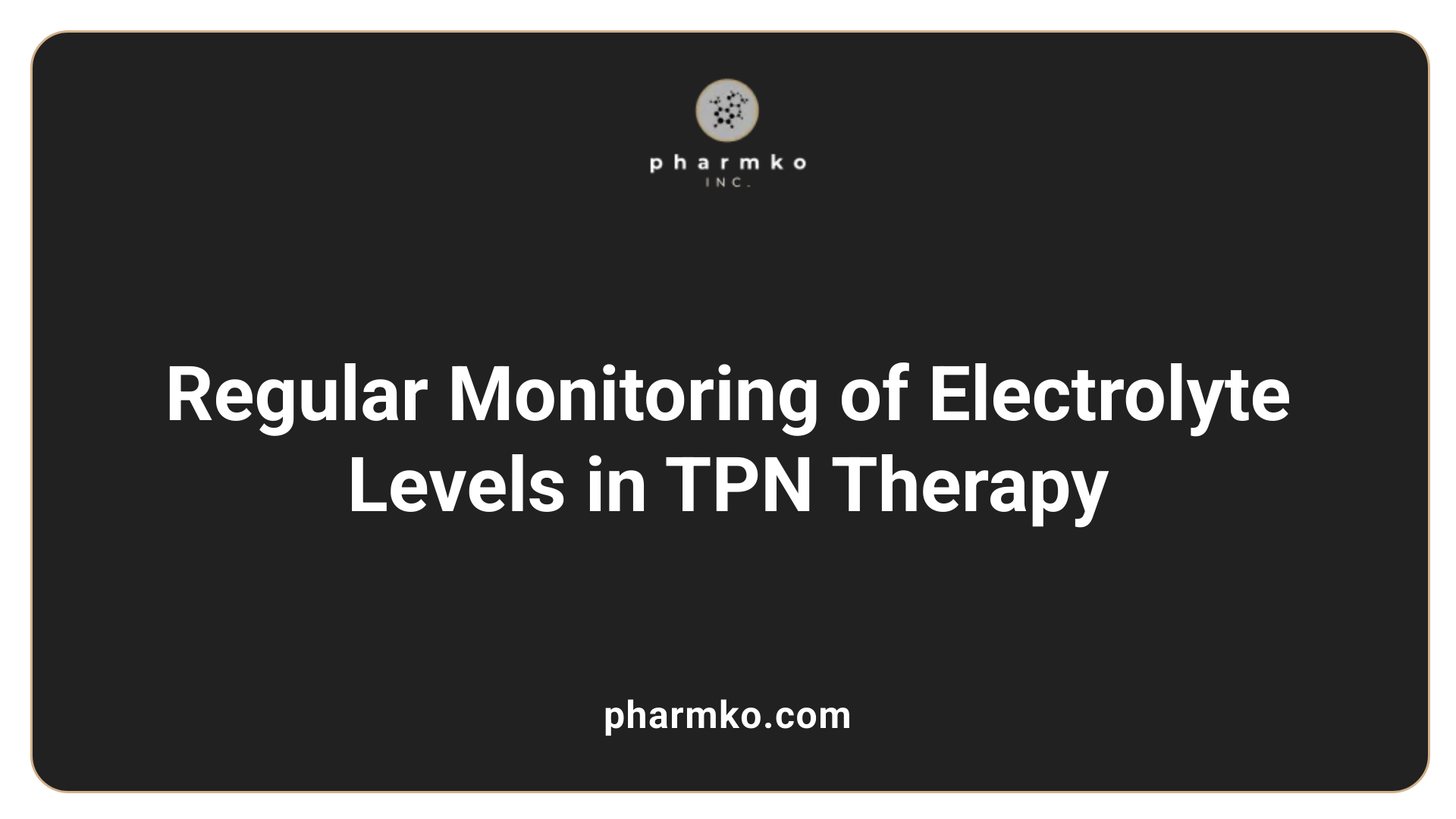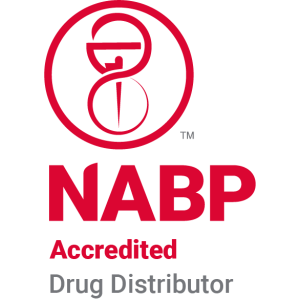Managing Electrolyte Imbalances in TPN Patients
Understanding the Critical Role of Electrolytes in TPN
Total Parenteral Nutrition (TPN) is a vital nutritional support modality for patients who cannot feed via the gastrointestinal tract. Central to the success of TPN therapy is meticulous management of electrolytes—minerals that maintain water and acid-base balance, support nerve and muscle functions, and facilitate cellular processes. Correctly balancing electrolytes like sodium, potassium, magnesium, calcium, and chloride ensures metabolic stability, minimizes complications, and enhances overall patient outcomes. This article explores the importance, monitoring strategies, management practices, and potential risks associated with electrolyte imbalances in TPN patients.
The Role and Significance of Electrolytes in TPN
What is the role of electrolytes in TPN therapy?
Electrolytes are vital minerals included in total parenteral nutrition (TPN) to maintain the body’s fluid and electrolyte harmony. They support fundamental functions such as nerve signal transmission, muscle contractions, and pH regulation. In TPN, electrolytes like sodium, potassium, magnesium, calcium, and chloride are supplied in carefully measured, sterile solutions tailored to each patient's needs. Regular blood tests monitor their levels, ensuring proper balance.
Managing electrolytes properly prevents dangerous complications, including irregular heartbeats, muscle weakness, and metabolic imbalances. Sodium helps regulate water balance and blood pressure, while potassium is crucial for kidney and nerve functions. Magnesium acts as a cofactor for enzymatic processes, and calcium supports neuromuscular activity. Chloride contributes to fluid movement and acid-base stability. Interestingly, acetate in TPN solutions serves as a buffer, helping to maintain a stable pH.
Overall, diligent electrolyte monitoring and supplementation in TPN therapy are essential for metabolic stability, preventing imbalance-related issues, and ensuring the best possible outcomes for patients receiving nutritional support.
Common Electrolyte Imbalances in TPN Patients
What are common electrolyte imbalances observed in patients receiving TPN?
Patients on total parenteral nutrition (TPN) frequently experience disturbances in their electrolyte levels. The most common imbalances include hyponatremia (low sodium), hypernatremia (high sodium), hypokalemia (low potassium), hyperkalemia (high potassium), hypomagnesemia (low magnesium), hypermagnesemia (high magnesium), hypocalcemia (low calcium), hypercalcemia (high calcium), hypophosphatemia (low phosphate), and hyperphosphatemia (high phosphate).
These issues often stem from improper formulation of the TPN solutions, inadequate monitoring, or the patient’s underlying health conditions such as kidney or liver dysfunction, hormonal irregularities, or ongoing fluid losses. If these imbalances are ignored or not corrected, they can lead to severe complications.
What are the underlying causes of these electrolyte imbalances?
Electrolyte imbalances can arise from various causes. In TPN patients, causes include mismatched electrolyte content in the infusion, rapid shifts in fluid compartments, or excessive losses through wounds, diarrhea, vomiting, or organ malfunction. For example, hypokalemia and hypomagnesemia may result from increased losses or inadequate supplementation.
Hormonal factors like vasopressin secretion can cause water retention leading to hyponatremia. Conversely, excessive saline infusions or dehydration can result in hypernatremia. Additionally, conditions like refeeding syndrome, characterized by sudden shifts in electrolytes including phosphate, magnesium, and potassium, frequently occur at the initiation of TPN in malnourished individuals.
What are the potential complications if these imbalances are not corrected?
Failing to promptly address electrolyte disturbances can have serious outcomes. Cardiac arrhythmias are a primary risk, especially with potassium and magnesium abnormalities. Neuromuscular symptoms, ranging from weakness to paralysis, may occur due to calcium, potassium, or magnesium issues.
Seizures, coma, and even death are possible in severe cases. Electrolyte imbalances can also impair kidney function, worsen heart health, and trigger neurological or muscular problems. Hence, regular monitoring and immediate adjustment of electrolyte levels in the TPN formulation are vital to ensure patient safety and prevent these complications.
Monitoring and Assessment of Electrolyte Levels in TPN

How should electrolyte levels be assessed and monitored in TPN patients?
Effective monitoring of electrolytes is vital for patients receiving total parenteral nutrition (TPN), as it helps prevent and manage imbalances that can lead to serious complications.
Electrolyte levels are primarily assessed through blood tests that measure serum sodium, potassium, calcium, magnesium, bicarbonate, and chloride. These tests should be conducted regularly, with the frequency depending on the patient’s clinical stability. Typically, initially, electrolyte levels are checked before starting TPN, then monitored daily or weekly during therapy, especially in critically ill or unstable patients.
In addition to electrolytes, renal function markers like serum creatinine and blood urea nitrogen (BUN) should be measured to evaluate kidney health. Liver function tests and serum proteins such as albumin and prealbumin are also monitored to assess nutritional status and metabolic response.
Trend analysis of these laboratory parameters is essential, as fluctuations are often more informative than isolated values. Changes in electrolyte concentrations should be interpreted alongside clinical signs, symptoms, and other laboratory results.
Adjustments to electrolyte supplementation must follow established guidelines. Modifications should be incremental to avoid overcorrection, which could cause further imbalances. For example, if hypokalemia is detected, potassium can be supplemented cautiously, considering the severity and the ongoing electrolyte trends.
This vigilant approach to monitoring helps minimize risks such as cardiac disturbances, neuromuscular problems, and renal issues, enhancing the safety and effectiveness of TPN therapy.
Guidelines for Preventing Electrolyte Imbalances During TPN
What are best practices for preventing electrolyte imbalances during TPN therapy?
Preventing electrolyte imbalances during total parenteral nutrition (TPN) involves careful planning and ongoing monitoring. First, clinicians should perform a comprehensive initial assessment of the patient, including baseline serum electrolyte levels, renal function, and overall nutritional needs. This assessment helps tailor the electrolyte content in the TPN solution to match individual requirements.
The formulation of electrolyte solutions must follow recommended ranges to maintain balance. For example, sodium levels are typically kept between 100-150 mEq, potassium between 50-100 mEq, calcium between 10-20 mEq, magnesium between 8-24 mEq, and phosphorus between 15-30 mEq per liter of TPN. Proper dilution and mixing are essential to prevent overcorrection or deficiencies.
Regular monitoring is critical. It is recommended to check serum electrolyte levels at least twice a week, especially during the first weeks of TPN therapy or following significant clinical changes. This frequent assessment allows for early detection of abnormalities such as hypo- or hypernatremia, hypokalemia, hypocalcemia, or hypomagnesemia.
Adjustments in electrolyte concentrations should be made promptly based on laboratory results and the patient_x007f_s clinical condition. Modifications may involve increasing or decreasing electrolyte supplementation or altering the overall composition of the TPN solution.
Additional best practices include initiating TPN gradually to reduce the risk of refeeding syndrome, which can cause rapid shifts in electrolytes. Ensuring that electrolyte components are well-diluted and compatible within the TPN mixture reduces the risk of destabilizing the patient_x007f_s metabolic balance.
Overall, a multidisciplinary approach involving physicians, pharmacists, and dietitians, along with strict adherence to guidelines, contributes to maintaining electrolyte stability and preventing associated complications during TPN therapy.
Management Strategies for Electrolyte Disturbances

What strategies are used to manage and correct electrolyte disturbances in patients on TPN?
Managing and correcting electrolyte disturbances during TPN therapy requires a systematic approach. Regular laboratory assessments are essential; serum electrolyte levels such as sodium, potassium, magnesium, calcium, and phosphorus are typically monitored twice weekly. This frequent checking allows healthcare providers to detect imbalances early, minimizing risks of severe complications.
Based on these lab results, clinicians adjust the electrolyte contents in the TPN mixture. This involves increasing or decreasing specific electrolytes to restore and maintain a balanced state, always considering the solubility limits and the potential for precipitate formation. Proper formulation ensures that the minerals stay in solution and do not cause harm.
In cases where serum levels are critically low or high, additional electrolyte supplementation can be administered separately from the TPN solution. For example, separate infusions of potassium or magnesium may be necessary if deficiencies are severe.
Addressing the underlying causes of imbalances is equally important. Fluid shifts, ongoing losses from wounds or gastrointestinal issues, or organ dysfunctions can influence electrolyte levels. Interventions such as fluid management strategies or medication adjustments are often implemented.
Throughout the TPN therapy, continuous clinical evaluation and labs guide adjustments. The goal is to maintain electrolyte homeostasis, preventing issues like cardiac arrhythmias, neuromuscular problems, or acid-base disturbances. Effective management of electrolytes enables safe and effective nutritional support during complex clinical conditions.
Clinical Considerations and Best Practices in Electrolyte Management
What are the clinical considerations and best practices for electrolyte management in TPN patients?
Managing electrolytes in patients receiving total parenteral nutrition (TPN) requires careful planning and ongoing assessment. Clinicians must individualize electrolyte prescriptions by considering each patient's specific nutritional needs, laboratory values, and overall clinical condition. This tailored approach helps prevent imbalances that could lead to serious complications.
Regular monitoring forms the backbone of safe electrolyte management. Initially, laboratory testing—such as serum electrolyte levels—should be conducted daily during the first few days of TPN initiation. Once stability is achieved, weekly checks are often sufficient, but more frequent testing may be necessary in critically ill or unstable patients. Key electrolytes monitored include sodium, potassium, magnesium, calcium, and phosphate.
Adjustments to electrolyte concentrations in the TPN solution are made based on laboratory results. This might involve increasing or decreasing specific electrolytes to correct deficiencies or prevent excesses. For example, if hypokalemia is detected, potassium can be supplemented accordingly.
Accuracy in compounding TPN solutions is essential. Proper aseptic techniques not only maintain sterility but also ensure the correct concentration of electrolytes. Any contamination or formulation error could jeopardize patient safety.
Healthcare providers should also consider other factors such as ongoing losses from wounds or drains, organ organ functions, medications, and concurrent illnesses. For instance, patients with kidney impairment may require different electrolyte management strategies than those with normal renal function.
Collaborative teamwork is vital. Dietitians, pharmacists, and clinicians must work together, following established guidelines and protocols to optimize electrolyte balance. Vigilance in tracking changes and readiness to intervene can significantly reduce risks of arrhythmias, neuromuscular issues, and metabolic disturbances.
In summary, individualized prescriptions, vigilant monitoring, proper sterile techniques, and interdisciplinary collaboration are the cornerstones of effective electrolyte management in TPN patients, ultimately supporting safer therapy outcomes and improved patient health.
Risks and Complications from Electrolyte Imbalances

What are the risks or complications associated with electrolyte imbalances in TPN therapy?
Electrolyte imbalances during Total Parenteral Nutrition (TPN) can have serious consequences if not properly managed. Among the most concerning are cardiac arrhythmias, which can arise from abnormalities like hypokalemia, hypocalcemia, and hypomagnesemia. These disturbances interfere with the heart’s electrical conduction, increasing the risk of irregular heartbeat, which can be life-threatening.
Neuromuscular issues are also common complications. For example, hypokalemia and hypocalcemia can lead to muscle weakness, cramps, and in severe cases, paralysis. Magnesium deficiency contributes to neuromuscular hyperexcitability, which can cause tremors or seizures.
Another significant concern is refeeding syndrome, a metabolic disturbance that occurs mainly in malnourished patients when nutrition is rapidly reintroduced. It involves rapid shifts in electrolytes like phosphate, potassium, and magnesium, combined with fluid overload. This syndrome can lead to severe complications such as seizures, cardiac failure, and kidney dysfunction.
Additionally, electrolyte imbalances can cause dehydration or fluid overload, impacting organ function and increasing the risk of infections or thrombosis. Hyperglycemia is also a common problem, particularly with high glucose formulations, which can induce metabolic stress on the kidneys and cardiovascular system.
In summary, failing to monitor and correct electrolyte disturbances in TPN can lead to life-threatening conditions, organ failures, and increased morbidity. Therefore, regular laboratory assessments and tailored TPN formulations are essential to minimize these risks.
Technical Aspects of Adjusting Electrolytes in TPN Formulations
What technical procedures are involved in adjusting electrolyte concentrations in TPN formulations?
Adjusting electrolyte concentrations in Total Parenteral Nutrition (TPN) depends on a careful process of calculation, clinical judgment, and ongoing monitoring. Healthcare providers start by assessing the patient’s current electrolyte levels through blood tests, considering factors such as renal function, medication effects, and losses due to diarrhea, wounds, or other conditions.
Based on laboratory data and clinical needs, clinicians use specific formulas and guidelines to determine how much of each electrolyte—sodium, potassium, magnesium, calcium, and phosphorus—should be added or adjusted in the TPN mixture. These calculations often involve translating lab values into appropriate dose adjustments, keeping in mind the normal range and the patient’s unique requirements.
For example, if a patient has hypokalemia (low potassium), the clinician will add an amount of potassium chloride to raise serum levels, guided by formulas that consider current serum concentration, target levels, and expected losses.
Regular monitoring is essential; electrolyte labs are typically checked initially at baseline, then during the initiation phase, and routinely thereafter—often twice weekly in unstable patients or weekly in stable cases. This data guides further modifications, allowing prompt correction of imbalances.
Adjustments are also made considering acid-base balance and ongoing metabolic responses. For example, if a patient develops hypercalcemia, calcium levels in TPN may need to be reduced or temporarily suspended. Conversely, if hypophosphatemia occurs, phosphate supplementation is added gradually.
This meticulous process requires a multidisciplinary approach, with pharmacists and clinicians collaborating closely to tailor the electrolyte content carefully. The ultimate goal is to maintain electrolyte homeostasis, prevent complications like arrhythmias or neuromuscular disturbances, and adapt to changing clinical conditions.
Recognition and Management of Specific Electrolyte Disturbances

How are specific electrolyte disturbances like hyponatremia or hyperkalemia managed in TPN patients?
Managing electrolyte imbalances in patients receiving Total Parenteral Nutrition (TPN) requires careful, individualized attention. The approach depends on the specific disturbance, the patient’s overall condition, and underlying causes.
For hyponatremia, the goal is to correct water excess gradually to avoid neurological complications like osmotic demyelination. This often involves adjusting the sodium content in the TPN formulation and careful monitoring of serum sodium levels. Sometimes, fluid restriction or medications like vasopressin receptor antagonists may be used alongside sodium correction strategies.
Hyperkalemia, on the other hand, necessitates reducing or temporarily withholding potassium from the TPN mixture. Additional treatments can include administering agents such as insulin with glucose to promote cellular uptake of potassium, or using medications like beta-agonists. Addressing the root cause is critical, such as managing renal impairment or reversing effects of medications that cause potassium retention.
Routine serum electrolyte monitoring is essential—most guidelines recommend checking levels at least twice weekly. Adjustments should be made based on lab results, clinical status, and the presence of signs or symptoms. Correcting these electrolyte issues often involves teamwork among healthcare providers, including physicians, pharmacists, and dietitians.
In summary, managing disturbances like hyponatremia and hyperkalemia in TPN therapies hinges on tailored electrolyte adjustments, ongoing monitoring, and treating underlying causes to maintain balance and prevent complications.
Electrolyte Imbalances and Refeeding Syndrome: Recognition and Prevention

How can electrolyte-related complications like refeeding syndrome be recognized and addressed?
Refeeding syndrome (RFS) is a serious complication that can occur when nutrition is reintroduced too rapidly in malnourished patients. Recognizing and managing RFS involves vigilant monitoring of blood electrolyte levels, especially phosphate, potassium, magnesium, and thiamine.
In high-risk patients—those with severe malnutrition, significant weight loss, or prolonged fasting—early signs of RFS can manifest as muscle weakness, irregular heartbeat, seizures, or breathing difficulties. Laboratory tests often reveal critical deficiencies: low phosphate (hypophosphatemia), low potassium (hypokalemia), low magnesium (hypomagnesemia), and vitamin B1 deficiency (thiamine).
Prevention begins with identifying these high-risk individuals through thorough clinical assessments, including evaluation of nutritional status and electrolyte levels. It is essential to initiate refeeding cautiously by starting with low-calorie diets and gradually increasing intake.
Electrolyte and vitamin supplements should be promptly given to correct existing deficiencies. This means supplementing phosphate, potassium, magnesium, and thiamine before and during the refeeding process.
During the first week of refeeding, frequent laboratory monitoring—ideally daily—is crucial to detect early shifts in electrolyte levels. Adjustments in nutrition and supplementation should be made based on these results to prevent severe complications.
A team approach involving physicians, dietitians, and pharmacists ensures comprehensive management. Combining careful refeeding protocols with continuous electrolyte and vitamin monitoring helps mitigate the risks associated with refeeding syndrome, promoting safer nutritional recovery for vulnerable patients.
By following these strategies, healthcare providers can effectively recognize, prevent, and address electrolyte disturbances during TPN and other nutritional interventions, thereby reducing morbidity and improving outcomes.
Impact of Electrolyte Imbalances on Patient Outcomes
How do electrolyte imbalances impact patient outcomes during TPN therapy?
Electrolyte imbalances are a common concern in patients receiving total parenteral nutrition (TPN). These disturbances can significantly affect patient health, leading to serious complications. For instance, deficiencies or excesses of key electrolytes such as potassium, magnesium, and calcium can cause irregular heart rhythms, neuromuscular problems, and metabolic disturbances.
If not properly monitored and corrected, these imbalances can result in increased morbidity and mortality. For example, hypokalemia and hypomagnesemia are linked to arrhythmias, which can be life-threatening if untreated. Additionally, electrolyte disturbances can impair organ functions, delay recovery, and worsen overall prognosis.
Studies highlight the importance of a multidisciplinary approach in managing these risks. The involvement of nutrition support teams—comprising physicians, pharmacists, and dietitians—has been shown to reduce the incidence of electrolyte abnormalities.
Appropriate and timely adjustments to electrolyte content in TPN solutions help prevent complications such as refeeding syndrome, liver issues, and kidney dysfunction. Regular laboratory assessments—involving serum electrolyte levels, kidney function tests, and glucose monitoring—are critical in early detection and intervention.
Ultimately, maintaining electrolyte balance is essential for supporting metabolic stability, organ function, and recovery. Ensuring vigilant oversight through coordinated care improves patient safety and outcomes during TPN therapy.
| Aspect | Impact | Additional Notes |
|---|---|---|
| Morbidity & Mortality | Reduced with proper electrolyte management | Includes decrease in arrhythmias, neuromuscular or metabolic complications |
| Organ Function | Preservation of heart, kidney, neuromuscular systems | Electrolytes are vital for cellular and organ health |
| Role of Multidisciplinary Teams | Critical for monitoring and adjustment | Leads to better electrolyte stability and lower complication rates |
Ensuring Safe and Effective TPN Electrolyte Management
Proper management of electrolytes during TPN therapy is crucial for preventing complications and promoting optimal patient recovery. Regular assessment, individualized formulation, vigilant monitoring, and interdisciplinary collaboration form the cornerstone of safe electrolyte handling. Awareness of risks such as refeeding syndrome and kidney dysfunction, along with adherence to evidence-based guidelines, ensures that electrolyte imbalances are swiftly identified and corrected. Continuous education, technical precision in compounding, and proactive patient care strategies are essential to improve outcomes and reduce morbidity associated with TPN. Ultimately, meticulous electrolyte management not only sustains physiological stability but also enhances the quality of care for vulnerable patients requiring parenteral nutrition.
References
- Understanding TPN Electrolytes: Maintaining Vital Balance in Total ...
- Total Parenteral Nutrition - StatPearls - NCBI Bookshelf
- Guidelines for Managing Electrolytes in Total Parenteral Nutrition ...
- Metabolic Complications of TPN - AmeriPharma® Specialty Care
- [PDF] Fluid and Electrolytes in Adult Parenteral Nutrition
- [PDF] The Hitchhiker's Guide to Parenteral Nutrition Management for Adult ...
- [PDF] Strategies for Parenteral Nutrition Management in Adult Patients
- Techniques and Procedures: Guidelines for Managing Electrolytes ...
- Parenteral Nutrition Electrolyte Abnormalities and Associated ...













